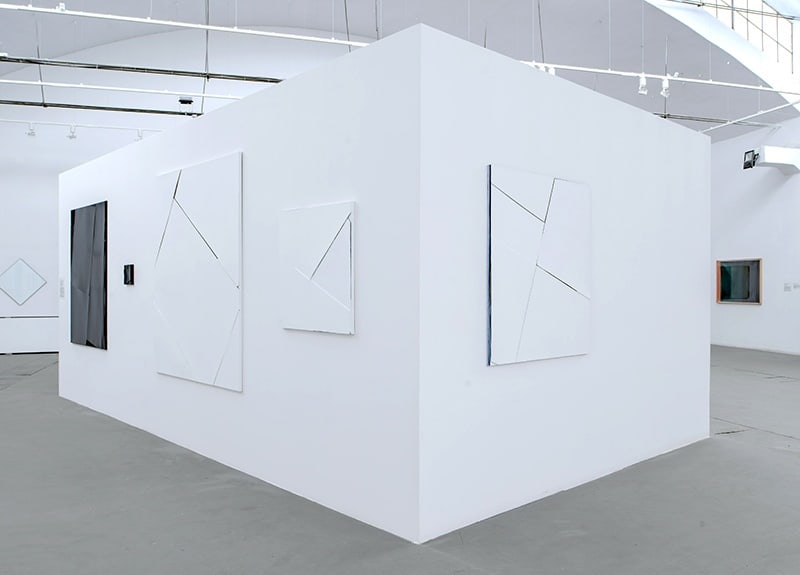She recently graduated from the Academy of Fine Arts in Vienna, where she collaborates with Christine König Galerie. Her extraordinary sensibility conquers beauty as well as simplicity. Natalia Załuska makes art which is associated with tranquility, contemplation and stillness. She captures a type of refinement of clarity you can’t ignore simply and elegantly.
Rarely do we encounter an artist who handles canvas, space and colour in such a tremendously skillful and original fashion.
The stream – in various shades of blue – traverses the vast, deep black terrain and flows into a small pool where heaven meets earth, where the dichotomy is ultimately eliminated. The incessant struggle intrinsic in the notion of contrast, however, does not cause any breach. Instead, a unified transcendence and brand new qualities emerge. It is just one of many equally valid interpretations the viewer of Natalia Załuska’s works could offer since their minimalism carries an incredible wealth of meaning.
Natalia Załuska is a Polish artist who studied under Daniel Richter at the Academy of Fine Arts in Vienna, which is where she lives and works. She opts for the simplicity of execution founded upon her exploration of colour and surface. As an alternative to paint, she uses cardboard, putting it through various modifications which make it change thickness, texture, colour and shape. Three-dimensional porous compositions defy the plainness – which would seem inevitable due to Załuska’s preferred material, which she cuts through with narrow cracks permeating contrasting hues. However, the colour range in her work is deliberately limited. The artworks usually combine two distinct shades, such as black and blue or black and white; the latter of which seems to be a dominant one. Occasionally, Załuska’s works are transformed due to the artist’s own intervention, e.g. a unique yet barely traceable pencil line that nevertheless adds a startling degree of depth. Załuska’s pieces feature unelaborate geometric shapes against a contrasting backdrop, which seems deconstructed and fragmented on account of the openings made on its surface. Those ‘rifts’ not only disrupt the tranquility and harmony, but they also affect your perception, which acquires a brand new quality. The primary subjects of Załuska’s works are dimension, depth, co-dependence and co-existence.

Natalia Załuska, Detail, courtesy Galerie Klüser, Munich
Amid the apparent simplicity, all sorts of different meanings abound in Natalia Załuska’s works. Does her ingenious approach towards minimalism hinder an audience’s understanding of a piece? Although individual works bear a striking resemblance to each other, every single one of them carries diverse connotations and communicates diverse messages.
Her works could be juxtaposed with those of Edward Krasiński, the Polish artist who in the 1970s marked the space with a blue scotch tape with the view of defining and arranging the space…
Her works could be juxtaposed with those of Edward Krasiński, the Polish artist who in the 1970s marked the space with a blue scotch tape with the view of defining and arranging the space, as well as its relation to an object. Another comparison with her could be also drawn with Barnett Newman who mercilessly interrupted fields of colour by vertical stripes or zips that revived the surrounding space. Rarely do we encounter an artist who handles canvas, space and colour in such a tremendously skillful and original fashion.

Natalia Załuska, Installation view: Christine König Galerie, courtesy Christine König Galerie, Vienna

Natalia Załuska, Installation view: Mere formality, Galeria Labirynt, photo Wojciech Pacewicz

Natalia Załuska, courtesy Christine König Galerie, Vienna








